My Cycling Tour in Oaxaca, Oaxaca 1
July 15-22, Oaxaca
7/15/06 Saturday - A first-day adventure
Somehow I accidentally left the paper with my homestay
information at home. On the plane from Mexico City I happened to hear a lady behind
me mention the word "Instituto" so I turned around and talked her into loaning me her
copy. I scribbled the information on the back of my ticket envelope.
It was a good thing I did.
When I arrived at the airport, someone from the homestay family was supposed to be
there to greet me. I waited around for awhile and finally took a taxicab to the address
I had written down. The airport cab was 270 pesos (almost $25) since I was the only
passenger in the van. I'm told that a taxi that starts in the city and goes to
the airport is much cheaper.
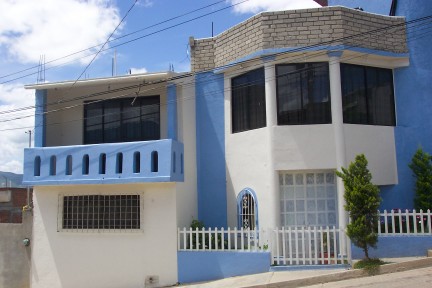 The taxista had a little trouble finding the place and when he did there was nobody
home. I had visions of sitting on my suitcases on the sidewalk. He talked to the next-door
neighbor who confirmed it was the right house. The neighbor kindly invited me in to
wait. This was about 8 PM. I asked the driver if I could give him a little something for
all his trouble. 50 pesos. It must have been a reasonable amount as he seemed happy.
The taxista had a little trouble finding the place and when he did there was nobody
home. I had visions of sitting on my suitcases on the sidewalk. He talked to the next-door
neighbor who confirmed it was the right house. The neighbor kindly invited me in to
wait. This was about 8 PM. I asked the driver if I could give him a little something for
all his trouble. 50 pesos. It must have been a reasonable amount as he seemed happy.
The neighbor lives with his wife and young son (maybe 4 years old?) in a tiny one-room
walk-in with a cement floor. There's a small cubicle walled off in one corner which I
assume is the bathroom. Mama was outside in the driveway washing clothes in a bucket.
They gave me a chair and I watched TV while I waited. They were tuned to channel 9,
the local government channel, which had a program on last year's Guelaguetza, the annual
multi-day folk festival which is the reason the SRJC program was scheduled at this time.
At one point he excitedly pointed out that the venue being shown on the TV is just up the
hill from here and it's happening right now (en vivo, or "live"). I could tell by
the quality of the video editing that it's actually a recording but at least I had something
interesting to watch while waiting.
I'd been up since 2:15 AM (4:15 Oaxaca time) and had not had dinner so I was kind of
out of it. We discussed having him call a hotel for me, but he kept saying I should wait a
little longer.
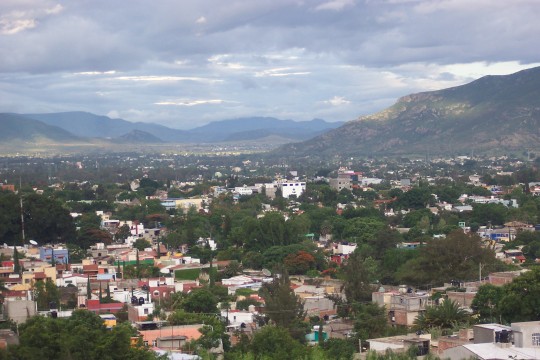 Finally about 10:00 the family showed up. I thanked the neighbor profusely for his
kindness. He told me his name but my deadened brain didn't retain it. [Wilfrido] It turns
out the family thought I was coming tomorrow. They were very apologetic. The wife
(Monica) made me a chicken leg in a nice sauce plus tortillas and Coke. They introduced
me to his father [Benito] who had returned with them, their son Alejandro (Alex) Junior
and their daughter whose name I forget. [Denisse, pronounced "Denise"] I had a long
conversation with grandfather while I ate.
Finally about 10:00 the family showed up. I thanked the neighbor profusely for his
kindness. He told me his name but my deadened brain didn't retain it. [Wilfrido] It turns
out the family thought I was coming tomorrow. They were very apologetic. The wife
(Monica) made me a chicken leg in a nice sauce plus tortillas and Coke. They introduced
me to his father [Benito] who had returned with them, their son Alejandro (Alex) Junior
and their daughter whose name I forget. [Denisse, pronounced "Denise"] I had a long
conversation with grandfather while I ate.
The photo is from the porch on the roof of the house. It's similar to the view out my
bedroom window.
They told me breakfast is at 8:30, lunch at 2:00 and dinner around 8:30, which
are typical times for Mexico. They removed the bed from my room and carried up a
bigger one to accommodate my 6-ft, 7-inch (2.00m) body. The bathroom is right next
door to my room. In contrast to the neighbor's humble abode, they have a very nice
spacious home, similar to a middle-class home in California. This should work out just
fine.
7/16/06 Sunday - Settling in
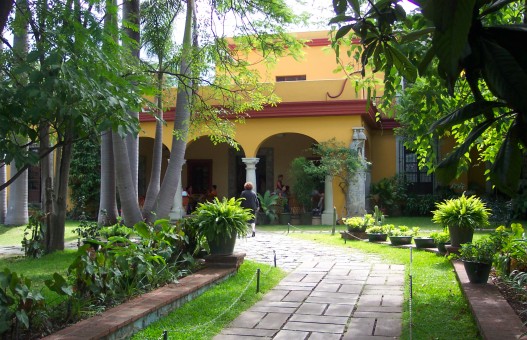 The daughter's name is Denisse. She's 3 years old and little Alex is 6. Alejandro senior
owns an aquarium/fish shop. A couple days ago he brought home an aquarium with a
couple fish. Little Alex is all sad that one of the fish died this morning. Father and son
are very affectionate. I remarked that they look very much alike which pleased them.
(¡Muy guapo!)
The daughter's name is Denisse. She's 3 years old and little Alex is 6. Alejandro senior
owns an aquarium/fish shop. A couple days ago he brought home an aquarium with a
couple fish. Little Alex is all sad that one of the fish died this morning. Father and son
are very affectionate. I remarked that they look very much alike which pleased them.
(¡Muy guapo!)
I took my map and my GPS and walked down to the Instituto just to make sure I know the
way tomorrow. It's less than a half-hour walk. The campus is quite beautiful.
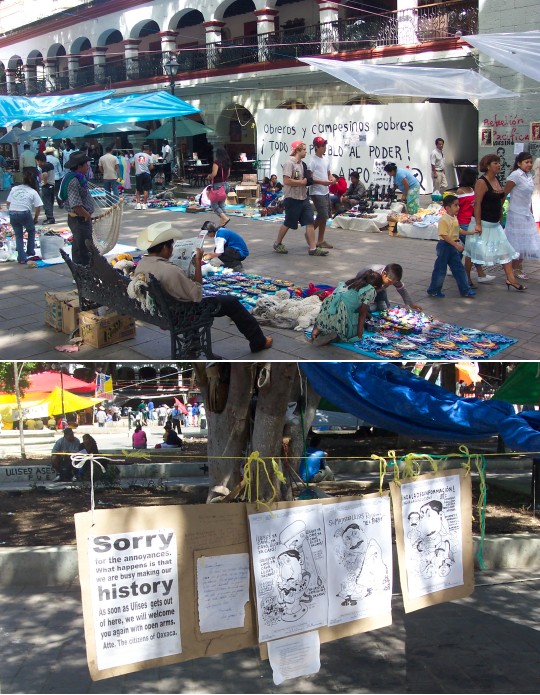 Then I went over to the Zócalo, the central plaza that is the focus of the old
(interesting) part of town. In amongst the normal street vendors, there are signs,
banners, and graffiti everywhere concerning the recent troubles. According to the signs,
the teachers' strike turned violent several weeks ago when the teachers' encampment in the
Zócalo was raided by the state police using helicopters, tear gas, and bullets.
Then I went over to the Zócalo, the central plaza that is the focus of the old
(interesting) part of town. In amongst the normal street vendors, there are signs,
banners, and graffiti everywhere concerning the recent troubles. According to the signs,
the teachers' strike turned violent several weeks ago when the teachers' encampment in the
Zócalo was raided by the state police using helicopters, tear gas, and bullets.
I was glad I had the GPS on the way back. I would have been lost for sure. (I have the
world's worst sense of direction.) The family are Jehovah's Witnesses (Testigos de
Jehovah). They went off to worship while I was walking.
9:45 PM. I'm sitting in my room listening to "Hotel California" playing on somebody's
boom box across the street. Earlier I assembled my bike in the room and took a siesta.
Tomorrow is the first day of classes.
7/17/06 Monday - Protests

On my way to school this morning there were busses blocking the streets and protesters
on the same corner as yesterday. A TV cameraman was recording a man giving some
kind of speech on the sidewalk. Because of the protests, the Guelaguetza has been canceled
for the first time in 74 years. We are to get our money back for the tickets.
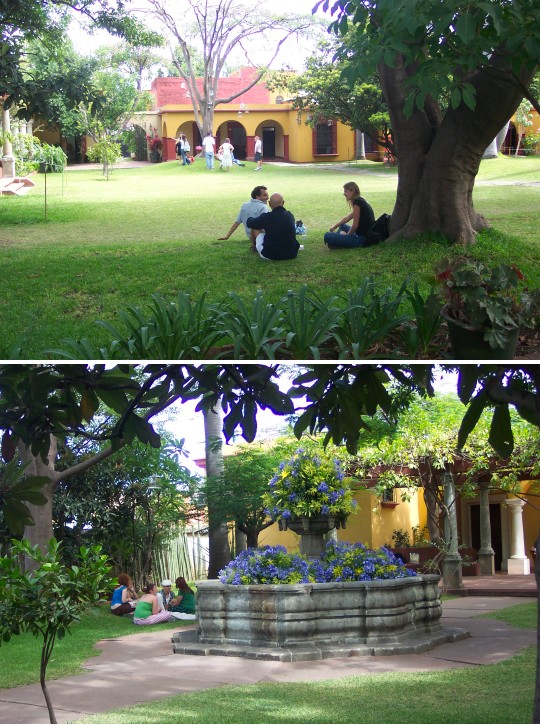 We had to arrive an hour early this morning for our introductory session and entrance
exam. On the basis of the exam I was placed in the last week of 1B. The instructor, Saúl,
is quite good. He has a high energy level and good teaching technique. We are studying
the preterite tense which is right where I was in my self-studies. Saúl said he is impressed
with how well I've been able to do without formal instruction.
We had to arrive an hour early this morning for our introductory session and entrance
exam. On the basis of the exam I was placed in the last week of 1B. The instructor, Saúl,
is quite good. He has a high energy level and good teaching technique. We are studying
the preterite tense which is right where I was in my self-studies. Saúl said he is impressed
with how well I've been able to do without formal instruction.
The morning session consists of 3 hours of Spanish instruction (all in Spanish) starting at
9:00, followed by one hour of conversation from 12:00-1:00. Our class meets by the fountain
for our conversation hour.
In the afternoon they offer
"cultural" classes from 4:00 to 6:00. This week I'm taking "History of Music" which consists
of the instructor, Misael, playing recordings of various traditional Mexican tunes (usually with
written text provided) followed by discussion (in Spanish of course). By the last 20 minutes
or so my brain was pretty fried from the effort of listening and speaking Spanish all day.
But total immersion is definitely the best way to learn.
After class I walk back to the homestay for comida, the main meal of the day, then
back to school for the afternoon session. The two round trips amount to well over 6 miles
of walking a day, including a pretty good hill to get to the house. That's good - I need the
exercise.
Tonight the SRJC group had a welcome dinner at El Asador Vasco restaurant on the Zócalo.
We were on the second floor that opens out onto the plaza. Very pleasant. I stopped at
an Internet cafe on the way back to check my email and was back at the house about 10:15.
I met my housemate, Jackson, a young man from Connecticut. I think he's in his last
week of studying Spanish at the Instituto. In an evil moment I asked Monica which of us
has the better accent. She really couldn't say. :=)
7/18/06 Tuesday - Intercambio
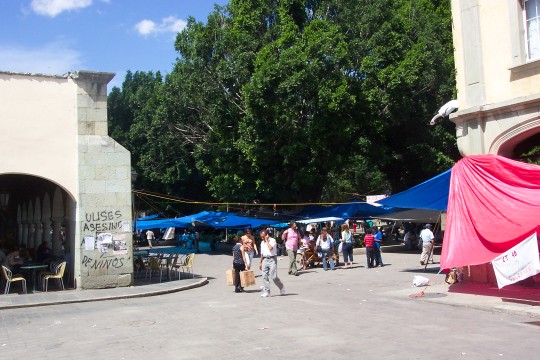 The roadblock was gone this morning but the paper announced the cancellation of the
Guelaguetza. There are graffiti everywhere saying "¡Ulises ya cayó!". Ulises Ruiz
is the governor of Oaxaca state who is blamed for the violence last month.
The roadblock was gone this morning but the paper announced the cancellation of the
Guelaguetza. There are graffiti everywhere saying "¡Ulises ya cayó!". Ulises Ruiz
is the governor of Oaxaca state who is blamed for the violence last month.
I've finally figured out the system of classes at the Instituto. There are six 4-week
courses, numbered 1A to 3B. They started me in the final week of 1B. I'll do the first
week of 2A next week.
Today after the afternoon music history class I had my first intercambio where you
meet for an hour with a student studying English at a local institution. You speak half in
each language. My student is named Ivan Arteta, a Russian first name and Spanish
family name. Turns out he is into classical guitar. We spent some time discussing music,
among other things.
7/19/06 Wednesday - Routine
The days are already starting to settle into a routine. Yesterday we had one student in my
class drop to a lower level and today we had a new student, Adrian, moving up. The
others are Amy, Emily, Addy, George, and Marissa. With five lithesome young women
in the class it can be a little hard to concentrate at times.
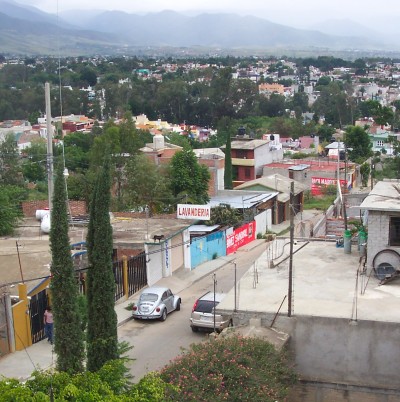 On my way home from lunch I stopped in a little papeleria to buy a couple notebooks.
I no longer seem to have any Spanish anxiety doing something like that. I generally chat
with Monica at lunch and Alejandro and Monica at dinner. So I'm spending almost the
whole day learning Spanish.
On my way home from lunch I stopped in a little papeleria to buy a couple notebooks.
I no longer seem to have any Spanish anxiety doing something like that. I generally chat
with Monica at lunch and Alejandro and Monica at dinner. So I'm spending almost the
whole day learning Spanish.
Denisse likes to play with crickets. She had two of them on the floor. The Spanish word
is grillo.
Monica was kind enough to drop off my laundry at the lavanderia just down the street
after they opened this morning. I retrieved them when I got back. For 42 pesos (less than
$4) you get up to 3.5 kg of clothes washed, dried, and neatly folded.
7/20/06 Thursday - The big aquarium
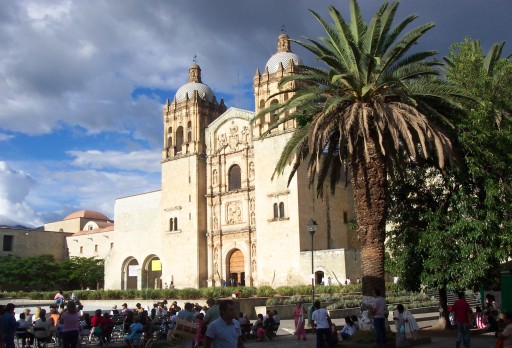 The photo is of the Iglesia Santo Domingo.
The photo is of the Iglesia Santo Domingo.
The music class is quite interesting. In addition to traditional Mexican songs we
occasionally listen to something more modern. My favorite is Ahora te puedes
marchar. It's sung to the tune of "I only want to be with you" but the Spanish words
have the opposite meaning, "If you can't love me you can take a hike." :=)
The big news today is that Alejandro brought home a new aquarium. This one is huge -
about 8 feet long. He says it holds 1300 liters and will weigh 1.5 metric tons (including
the gravel) when full. I helped carry it in. The kids, especially Alejandrito, really like the
fishes and this is a surprise present.
I had my first cup of atole de avena, a hot drink made from oats. Monica said I didn't
have to drink it if I didn't like it but it was kind of good.
7/21/06 Friday - Grilled grasshoppers
This was the last week of class for the 4-week session so they had a little fiesta at the
Instituto after class with a mariachi band and snacks.
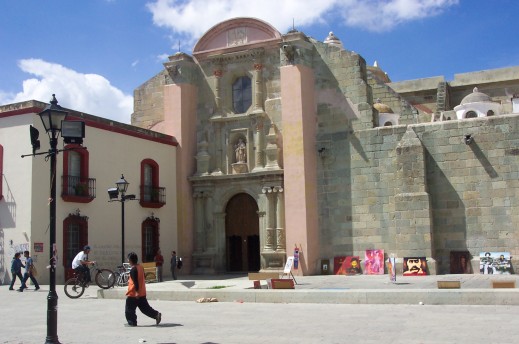 There is no afternoon "culture" class on Fridays so after lunch I went downtown and
visited the church and museum of Santo Domingo.
There is no afternoon "culture" class on Fridays so after lunch I went downtown and
visited the church and museum of Santo Domingo.
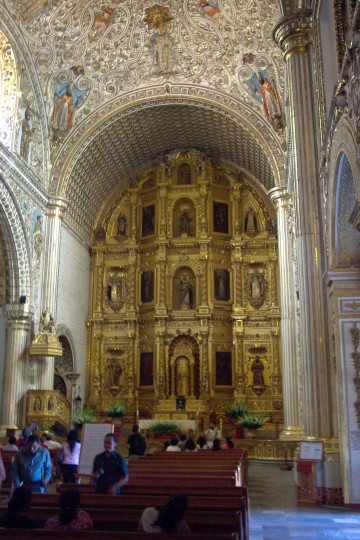 The interior of the church is filled
with ornate decorations and filigree, all covered with gold leaf. The museum is like a
mini-Smithsonian. It covers all of Oaxaca's historical and pre-historical periods, but I
was especially interested in the room with the contents of tomb 7 at Monte Alban.
The interior of the church is filled
with ornate decorations and filigree, all covered with gold leaf. The museum is like a
mini-Smithsonian. It covers all of Oaxaca's historical and pre-historical periods, but I
was especially interested in the room with the contents of tomb 7 at Monte Alban.
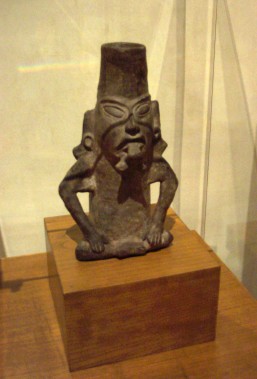
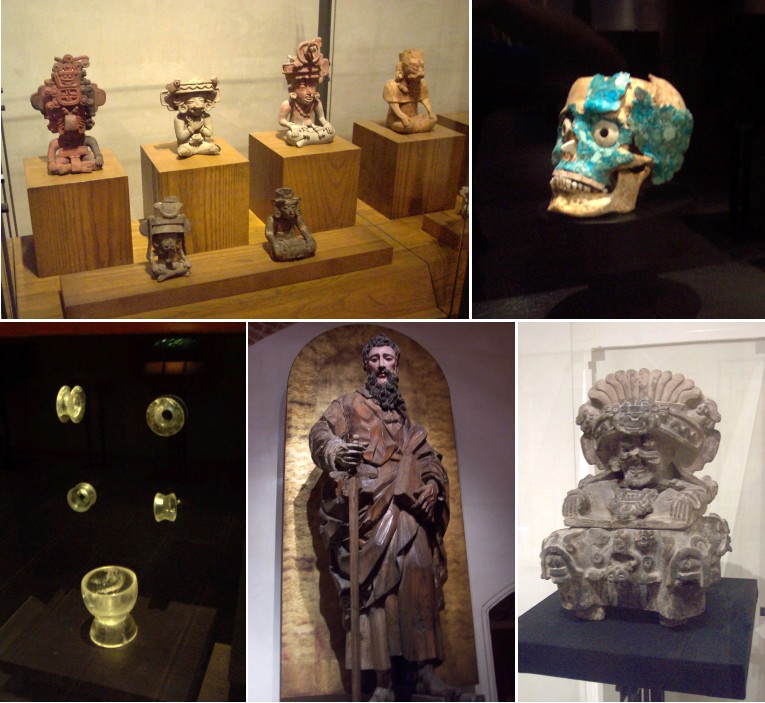
On the way back I bought some musica typica cassettes at a tiny shop recommended by
the music teacher on Av. Morelos between Vigil and Alcalá. I also got some money from
an ATM and checked out the Mercado de Artesanias, the handicrafts market. It's just
a couple blocks from the main market on 20 de noviembre.
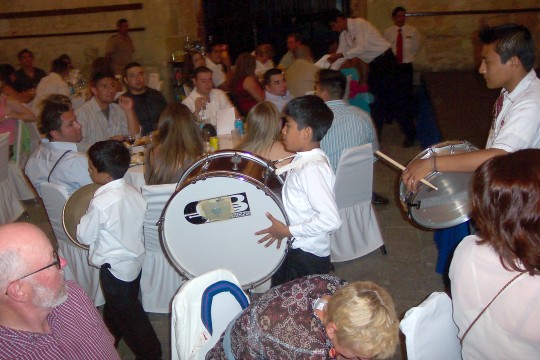 Since the Guelaguetza was canceled we used our refunded ticket money to attend a dinner
and show at the Camino Real hotel and restaurant on 5 de Mayo. The show started with a
brass band, led by two young boys leading the percussion section, marching through the
dining room.
Since the Guelaguetza was canceled we used our refunded ticket money to attend a dinner
and show at the Camino Real hotel and restaurant on 5 de Mayo. The show started with a
brass band, led by two young boys leading the percussion section, marching through the
dining room.
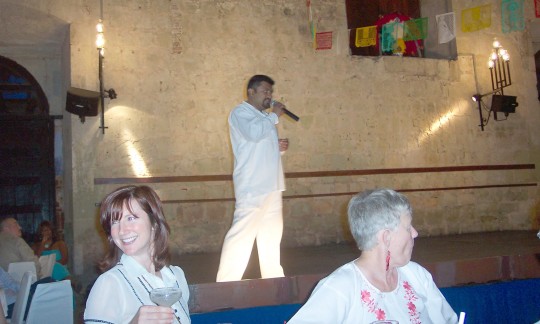 The band then accompanied a dance troup that did a traditional dance from
each region of Oaxaca. I don't know how they were able to change their elaborate
costumes in the few minutes the announcer spent explaining the next dance. Very
impressive. I hope my photos come out.
The band then accompanied a dance troup that did a traditional dance from
each region of Oaxaca. I don't know how they were able to change their elaborate
costumes in the few minutes the announcer spent explaining the next dance. Very
impressive. I hope my photos come out.
You can view a couple short .MOV files of two dances by clicking here:
Dance 1 - Dance 2.

The buffet dinner was nearly worth the price of admission all by itself. I had another new
dish tonight, papas con chapulines, potatoes with grilled grasshopper. It was excellent.
7/22/06 Saturday - A breakthrough in Spanish
At breakfast Monica apologized for still being in her sweat clothes after her morning run
in the park on the nearby hill, Cerro del Fortín. We practiced her English a bit. She's
actually better at it than she thinks.
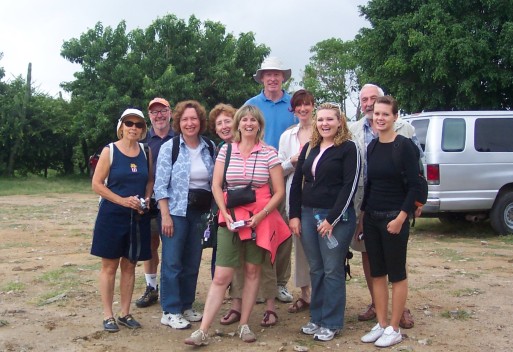 Today I went with about half of the SRJC group on a guided bus tour of Monte Alban,
Arrazola, and San Bartolo Coyotepec. That's me in the rear with the dorky hat,
behind the SRJC group leader, Kimberlee, in the front row.
Today I went with about half of the SRJC group on a guided bus tour of Monte Alban,
Arrazola, and San Bartolo Coyotepec. That's me in the rear with the dorky hat,
behind the SRJC group leader, Kimberlee, in the front row.
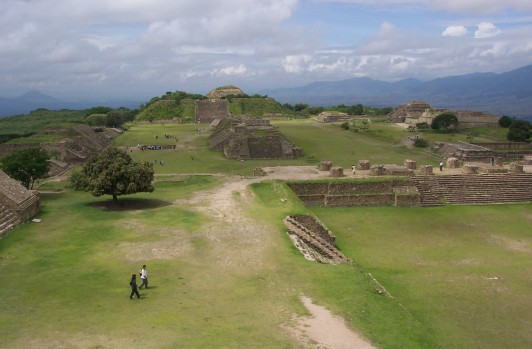 At Monte Alban are the ruins of the oldest city in Mexico, built by the Zapotecs starting
about 500 BC.
At Monte Alban are the ruins of the oldest city in Mexico, built by the Zapotecs starting
about 500 BC.
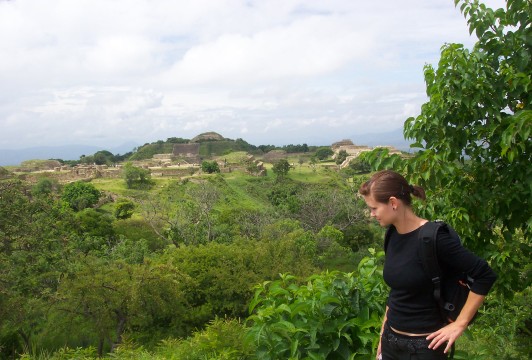
I bought a stone mask and a couple figurines from a vendor. These are actual genuine
Zapotec artifacts (but not old). The Zapotec man I bought them from made
them himself. He showed me his calluses to prove it.
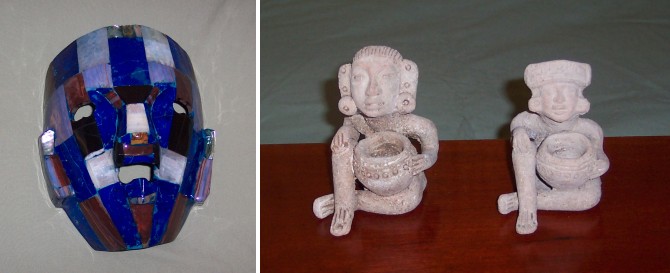
 Arrazola is famous for alebrijes, fanciful painted wooden creatures you find in gift
shops all over Mexico. We stopped at an alebrije factory and watched crafts (wo)men
working while listening to a guy with a "Surfin" T-shirt explain how it's done. I bought a
little rabbit.
Arrazola is famous for alebrijes, fanciful painted wooden creatures you find in gift
shops all over Mexico. We stopped at an alebrije factory and watched crafts (wo)men
working while listening to a guy with a "Surfin" T-shirt explain how it's done. I bought a
little rabbit.
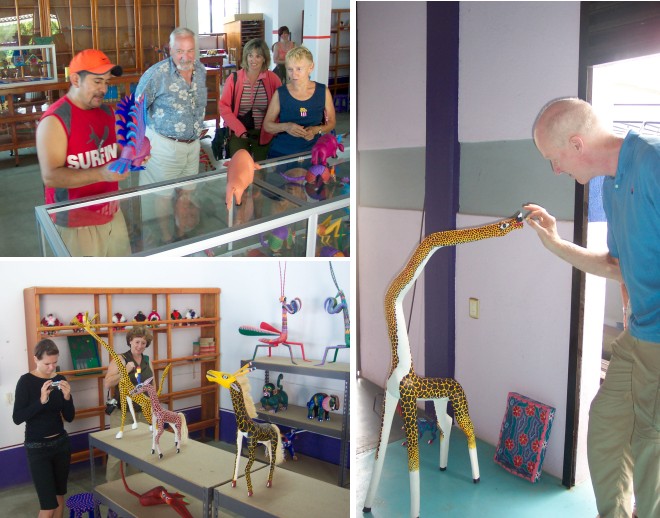
 San Bartolo is famous for barro negro, the black pottery that is also sold all over
Mexico. The special technique to get the shiny black surface without using paint was invented
in the 1950s by Doña Rosa, who died in 1980. We watched a demonstration by her son who
said he has been making pottery for 67 years. His commentary was translated into
English by our guide. I bought a couple items, including a small black cat.
San Bartolo is famous for barro negro, the black pottery that is also sold all over
Mexico. The special technique to get the shiny black surface without using paint was invented
in the 1950s by Doña Rosa, who died in 1980. We watched a demonstration by her son who
said he has been making pottery for 67 years. His commentary was translated into
English by our guide. I bought a couple items, including a small black cat.

We were supposed to stop to see the ex-convent of Santiago in Cuilapan de Guerrero.
The basilica has no ceiling since the natives were uncomfortable not being able to see the
sky. Since it was raining heavily at the time we just drove on.
Two young French women, friends of Monica's brother, arrived tonight to spend a few
days. Vanessa and Coralie are sisters from the French island of Réunion in the Indian
Ocean. When Alejandro came home from work he spoke to them for a long time about
his visit to France some years ago, Mexican culture, etc. He spoke (it was mostly him
speaking) for nearly three hours and I understood almost all of it! That's the first time in
my life I have ever had such an experience in a foreign language. Either my Spanish is
really improving or he is very good at speaking clearly and simply. Probably both.
Back - Top - Forward
 The taxista had a little trouble finding the place and when he did there was nobody
home. I had visions of sitting on my suitcases on the sidewalk. He talked to the next-door
neighbor who confirmed it was the right house. The neighbor kindly invited me in to
wait. This was about 8 PM. I asked the driver if I could give him a little something for
all his trouble. 50 pesos. It must have been a reasonable amount as he seemed happy.
The taxista had a little trouble finding the place and when he did there was nobody
home. I had visions of sitting on my suitcases on the sidewalk. He talked to the next-door
neighbor who confirmed it was the right house. The neighbor kindly invited me in to
wait. This was about 8 PM. I asked the driver if I could give him a little something for
all his trouble. 50 pesos. It must have been a reasonable amount as he seemed happy.
 Finally about 10:00 the family showed up. I thanked the neighbor profusely for his
kindness. He told me his name but my deadened brain didn't retain it. [Wilfrido] It turns
out the family thought I was coming tomorrow. They were very apologetic. The wife
(Monica) made me a chicken leg in a nice sauce plus tortillas and Coke. They introduced
me to his father [Benito] who had returned with them, their son Alejandro (Alex) Junior
and their daughter whose name I forget. [Denisse, pronounced "Denise"] I had a long
conversation with grandfather while I ate.
Finally about 10:00 the family showed up. I thanked the neighbor profusely for his
kindness. He told me his name but my deadened brain didn't retain it. [Wilfrido] It turns
out the family thought I was coming tomorrow. They were very apologetic. The wife
(Monica) made me a chicken leg in a nice sauce plus tortillas and Coke. They introduced
me to his father [Benito] who had returned with them, their son Alejandro (Alex) Junior
and their daughter whose name I forget. [Denisse, pronounced "Denise"] I had a long
conversation with grandfather while I ate.
 The daughter's name is Denisse. She's 3 years old and little Alex is 6. Alejandro senior
owns an aquarium/fish shop. A couple days ago he brought home an aquarium with a
couple fish. Little Alex is all sad that one of the fish died this morning. Father and son
are very affectionate. I remarked that they look very much alike which pleased them.
(¡Muy guapo!)
The daughter's name is Denisse. She's 3 years old and little Alex is 6. Alejandro senior
owns an aquarium/fish shop. A couple days ago he brought home an aquarium with a
couple fish. Little Alex is all sad that one of the fish died this morning. Father and son
are very affectionate. I remarked that they look very much alike which pleased them.
(¡Muy guapo!)
 Then I went over to the Zócalo, the central plaza that is the focus of the old
(interesting) part of town. In amongst the normal street vendors, there are signs,
banners, and graffiti everywhere concerning the recent troubles. According to the signs,
the teachers' strike turned violent several weeks ago when the teachers' encampment in the
Zócalo was raided by the state police using helicopters, tear gas, and bullets.
Then I went over to the Zócalo, the central plaza that is the focus of the old
(interesting) part of town. In amongst the normal street vendors, there are signs,
banners, and graffiti everywhere concerning the recent troubles. According to the signs,
the teachers' strike turned violent several weeks ago when the teachers' encampment in the
Zócalo was raided by the state police using helicopters, tear gas, and bullets.

 We had to arrive an hour early this morning for our introductory session and entrance
exam. On the basis of the exam I was placed in the last week of 1B. The instructor, Saúl,
is quite good. He has a high energy level and good teaching technique. We are studying
the preterite tense which is right where I was in my self-studies. Saúl said he is impressed
with how well I've been able to do without formal instruction.
We had to arrive an hour early this morning for our introductory session and entrance
exam. On the basis of the exam I was placed in the last week of 1B. The instructor, Saúl,
is quite good. He has a high energy level and good teaching technique. We are studying
the preterite tense which is right where I was in my self-studies. Saúl said he is impressed
with how well I've been able to do without formal instruction.
 The roadblock was gone this morning but the paper announced the cancellation of the
Guelaguetza. There are graffiti everywhere saying "¡Ulises ya cayó!". Ulises Ruiz
is the governor of Oaxaca state who is blamed for the violence last month.
The roadblock was gone this morning but the paper announced the cancellation of the
Guelaguetza. There are graffiti everywhere saying "¡Ulises ya cayó!". Ulises Ruiz
is the governor of Oaxaca state who is blamed for the violence last month.
 On my way home from lunch I stopped in a little papeleria to buy a couple notebooks.
I no longer seem to have any Spanish anxiety doing something like that. I generally chat
with Monica at lunch and Alejandro and Monica at dinner. So I'm spending almost the
whole day learning Spanish.
On my way home from lunch I stopped in a little papeleria to buy a couple notebooks.
I no longer seem to have any Spanish anxiety doing something like that. I generally chat
with Monica at lunch and Alejandro and Monica at dinner. So I'm spending almost the
whole day learning Spanish.
 The photo is of the Iglesia Santo Domingo.
The photo is of the Iglesia Santo Domingo.
 There is no afternoon "culture" class on Fridays so after lunch I went downtown and
visited the church and museum of Santo Domingo.
There is no afternoon "culture" class on Fridays so after lunch I went downtown and
visited the church and museum of Santo Domingo.
 The interior of the church is filled
with ornate decorations and filigree, all covered with gold leaf. The museum is like a
mini-Smithsonian. It covers all of Oaxaca's historical and pre-historical periods, but I
was especially interested in the room with the contents of tomb 7 at Monte Alban.
The interior of the church is filled
with ornate decorations and filigree, all covered with gold leaf. The museum is like a
mini-Smithsonian. It covers all of Oaxaca's historical and pre-historical periods, but I
was especially interested in the room with the contents of tomb 7 at Monte Alban.


 Since the Guelaguetza was canceled we used our refunded ticket money to attend a dinner
and show at the Camino Real hotel and restaurant on 5 de Mayo. The show started with a
brass band, led by two young boys leading the percussion section, marching through the
dining room.
Since the Guelaguetza was canceled we used our refunded ticket money to attend a dinner
and show at the Camino Real hotel and restaurant on 5 de Mayo. The show started with a
brass band, led by two young boys leading the percussion section, marching through the
dining room.
 The band then accompanied a dance troup that did a traditional dance from
each region of Oaxaca. I don't know how they were able to change their elaborate
costumes in the few minutes the announcer spent explaining the next dance. Very
impressive. I hope my photos come out.
The band then accompanied a dance troup that did a traditional dance from
each region of Oaxaca. I don't know how they were able to change their elaborate
costumes in the few minutes the announcer spent explaining the next dance. Very
impressive. I hope my photos come out.

 Today I went with about half of the SRJC group on a guided bus tour of Monte Alban,
Arrazola, and San Bartolo Coyotepec. That's me in the rear with the dorky hat,
behind the SRJC group leader, Kimberlee, in the front row.
Today I went with about half of the SRJC group on a guided bus tour of Monte Alban,
Arrazola, and San Bartolo Coyotepec. That's me in the rear with the dorky hat,
behind the SRJC group leader, Kimberlee, in the front row.
 At Monte Alban are the ruins of the oldest city in Mexico, built by the Zapotecs starting
about 500 BC.
At Monte Alban are the ruins of the oldest city in Mexico, built by the Zapotecs starting
about 500 BC.


 Arrazola is famous for alebrijes, fanciful painted wooden creatures you find in gift
shops all over Mexico. We stopped at an alebrije factory and watched crafts (wo)men
working while listening to a guy with a "Surfin" T-shirt explain how it's done. I bought a
little rabbit.
Arrazola is famous for alebrijes, fanciful painted wooden creatures you find in gift
shops all over Mexico. We stopped at an alebrije factory and watched crafts (wo)men
working while listening to a guy with a "Surfin" T-shirt explain how it's done. I bought a
little rabbit.

 San Bartolo is famous for barro negro, the black pottery that is also sold all over
Mexico. The special technique to get the shiny black surface without using paint was invented
in the 1950s by Doña Rosa, who died in 1980. We watched a demonstration by her son who
said he has been making pottery for 67 years. His commentary was translated into
English by our guide. I bought a couple items, including a small black cat.
San Bartolo is famous for barro negro, the black pottery that is also sold all over
Mexico. The special technique to get the shiny black surface without using paint was invented
in the 1950s by Doña Rosa, who died in 1980. We watched a demonstration by her son who
said he has been making pottery for 67 years. His commentary was translated into
English by our guide. I bought a couple items, including a small black cat.
